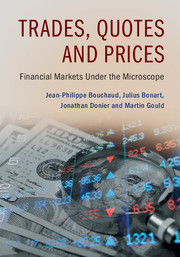Book contents
- Frontmatter
- Dedication
- Contents
- Preface
- Acknowledgements
- PART I HOW AND WHY DO PRICES MOVE?
- PART II LIMIT ORDER BOOKS: INTRODUCTION
- PART III LIMIT ORDER BOOKS: MODELS
- 5 Single-Queue Dynamics: Simple Models
- 6 Single-Queue Dynamics for Large-Tick Stocks
- 7 Joint-Queue Dynamics for Large-Tick Stocks
- 8 The Santa Fe Model for Limit Order Books
- PART IV CLUSTERING AND CORRELATIONS
- PART V PRICE IMPACT
- PART VI MARKET DYNAMICS AT THE MICRO-SCALE
- PART VII ADVERSE SELECTION AND LIQUIDITY PROVISION
- PART VIII MARKET DYNAMICS AT THE MESO-SCALE
- PART IX PRACTICAL CONSEQUENCES
- Appendix
- Index
- References
5 - Single-Queue Dynamics: Simple Models
from PART III - LIMIT ORDER BOOKS: MODELS
Published online by Cambridge University Press: 26 February 2018
- Frontmatter
- Dedication
- Contents
- Preface
- Acknowledgements
- PART I HOW AND WHY DO PRICES MOVE?
- PART II LIMIT ORDER BOOKS: INTRODUCTION
- PART III LIMIT ORDER BOOKS: MODELS
- 5 Single-Queue Dynamics: Simple Models
- 6 Single-Queue Dynamics for Large-Tick Stocks
- 7 Joint-Queue Dynamics for Large-Tick Stocks
- 8 The Santa Fe Model for Limit Order Books
- PART IV CLUSTERING AND CORRELATIONS
- PART V PRICE IMPACT
- PART VI MARKET DYNAMICS AT THE MICRO-SCALE
- PART VII ADVERSE SELECTION AND LIQUIDITY PROVISION
- PART VIII MARKET DYNAMICS AT THE MESO-SCALE
- PART IX PRACTICAL CONSEQUENCES
- Appendix
- Index
- References
Summary
Nothing is more practical than a good theory.
(L. Boltzmann)Modelling the full dynamics of an LOB is a complicated task. As we discussed in Chapter 3, limit orders can be submitted or cancelled at a wide range of different prices, and can also be matched to incoming market orders. Limit orders of many different sizes often reside at the same price level, where they queue according to a specified priority system (see Section 3.2.1). The arrival and cancellation rates of these orders also depend on the state of the LOB, which induces a feedback loop between order flow and liquidity and thereby further complicates the problem. Due to the large number of traders active in some markets, and given that each such trader can own many different limit orders at many different prices, even keeping track of an LOB's temporal evolution is certainly a challenge.
Despite these difficulties, there are many clear benefits to developing and studying LOB models. For example, analysing the interactions between different types of orders can help to provide insight into how best to act in given market situations, how to design optimal execution strategies, and even how to address questions about market stability. Therefore, LOB modelling attracts a great deal of attention from practitioners, academics and regulators.
Throughout the next four chapters, we introduce and develop a framework for LOB modelling. In the present chapter, we begin by considering the core building block of our approach: the temporal evolution of a single queue of limit orders, using highly simplified models. In Chapter 6, we extend our analysis to incorporate several important empirical facts into our theoretical description of single queues. In Chapter 7, we consider the joint dynamics of the best bid- and ask-queues together, from both a theoretical and an empirical point of view. Finally, in Chapter 8, we discuss how to extend these models to describe the dynamics of a full LOB. In all of these chapters, we aim to derive several exact results within the framework of simplified stochastic models, and approximate results for more realistic models calibrated to market data.
- Type
- Chapter
- Information
- Trades, Quotes and PricesFinancial Markets Under the Microscope, pp. 78 - 100Publisher: Cambridge University PressPrint publication year: 2018



